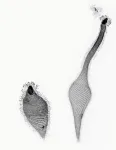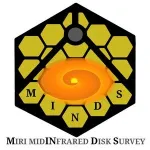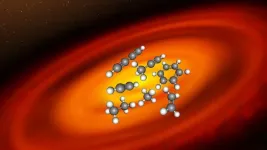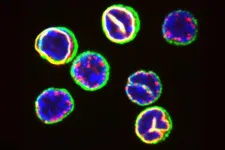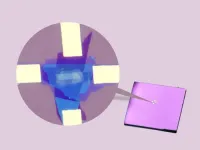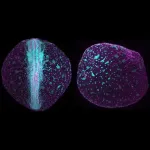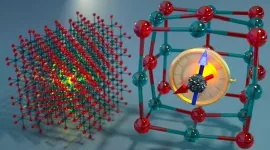(Press-News.org) “There are some things in life you can watch and then never unwatch,” said Manu Prakash, associate professor of bioengineering at Stanford University, calling up a video of his latest fascination, the single-cell organism Lacrymaria olor, a free-living protist he stumbled upon playing with his paper Foldscope. “It’s … just … it’s mesmerizing.”
“From the minute Manu showed it to me, I have just been transfixed by this cell,” said Eliott Flaum, a graduate student in the “curiosity-driven” Prakash Lab. Prakash and Flaum spent the last seven years studying Lacrymaria olor’s every move and recently published a paper on their work in Science.
“The first time I came back with a fluorescence micrograph, it was just breathtaking,” Flaum said. “That image is in the paper.”
The video Prakash queued up reveals why this organism is much more than a pretty picture: a single teardrop-shaped cell swims in a droplet of pond water. In an instant, a long, thin “neck” projects out from the bulbous lower end. And it keeps going. And going. Then, just as quickly, the neck retracts back, as if nothing had happened.
In seconds, a cell that was just 40 microns tip-to-tail sprouted a neck that extended 1500 microns or more out into the world. It is the equivalent of a 6-foot human projecting its head more than 200 feet. All from a cell without a nervous system.
“It is incredibly complex behavior,” Prakash said with a smile.
Form is function
L. olor is featured in Science because Prakash and Flaum have discovered in this behavior a new geometric mechanism previously unknown in biology. And they are the first to explain how such a simple cell can produce such incredible morphodynamics, beautiful folding and unfolding – aka origami – at the scale of a single cell, time and again without fail.
It is geometry. L. olor’s behavior is encoded in its cytoskeletal structure, just like human behavior is encoded in neural circuits.
“This is the first example of cellular origami,” Prakash said. “We’re thinking of calling it lacrygami.”
Specifically, it is a subset of traditional origami known as “curved-crease origami.” It is all based on a structure of thin, helical microtubules – ribs that wrap inside the cell’s membrane. These microtubule ribs are encased in a delicate diaphanous membrane, defining the crease pattern of peaks in a series of mountain-and-valley folds.
Prakash and Flaum used transmission electron microscopy and other state-of-the-art investigatory techniques to show there are actually 15 of these stiff, helical microtubule ribbons enshrouding L. olor’s cell membrane – a cytoskeleton. These tubules coil and uncoil, leading to long projection and retraction, nesting back into themselves like the bellows of a compressed helical accordion. The gossamer of membrane tucks away inside the cell in neat, well-defined pleats.
“When you store pleats on the helical angle in this way, you can store an infinite amount of material,” Flaum explained. “Biology has figured this out.”
Geometry is destiny
The elegance is in the arithmetic. It is mathematically impossible for this structure to unfold in any other way – and, conversely, only one way it can retract. What is perhaps more striking to Prakash is the robustness of the architecture. In its lifetime, L. olor will perform this projection and retraction 50,000 times without flaw, he said: “L. olor is bound by its geometry to fold and unfold in this particular way.”
The key is an under-studied mathematical phenomenon occurring at the precise point where the ribs twist and the folded membrane begins to unfurl. It is a singularity – a point where the structure is folded and unfolded at the same time. It is both and neither – singular.
Grabbing a piece of paper, Prakash folds it into a cone shape and then pulls on one corner of the paper to demonstrate how this singularity (called d-cone) travels across the sheet in a neat line. And, by pushing back on the corner how the singularity travels back the exact same path to its original position.
“It unfolds and folds at this singularity every time, acting as a controller. This is the first time a geometric controller of behavior has been described in a living cell.” Prakash explained.
Recreational biology
A constant theme running throughout the Prakash Lab’s work is a profound sense of wonder and playfulness that results in the energetic curiosity necessary to pursue such an idea for such a long time. It is, to put it in Prakash’s terms, old-school science. He also calls it recreational biology.
To demonstrate his inspiration, Prakash displayed a family tree of other single-celled organisms that he has chosen to study. True, none can do what L. olor can do, he said. But these intricate geometries come in thousands of forms. Beautiful? Certainly, but each is also hiding wonderful and unwritten rules under their sleeves.
“We started with a puzzle,” Prakash explained with all the seriousness a scientist can muster. “Ellie and I asked a very simple question: Where does this material come from? And where does it go? As our playground, we chose Tree of Life. Seven years later, here we are.”
As for practical applications, Prakash the engineer is already imagining a new era of deployable microscale “living machines” that could transform everything from space telescopes to miniature surgical robots in the operating room.
Prakash is also a senior fellow at the Stanford Woods Institute for the Environment, associate professor (by courtesy) of biology and of oceans, a member of Stanford Bio-X, the Wu Tsai Human Performance Alliance, the Maternal & Child Health Research Institute, and the Wu Tsai Neurosciences Institute.
This research was funded by the National Institutes of Health, the National Science Foundation, the Moore Foundation, the Howard Hughes Medical Institute, the Schmidt Foundation, and the Chan Zuckerberg Biohub San Francisco. Some of this work was performed at the Cell Sciences Imaging Facility at Stanford.
END
The first example of cellular origami
2024-06-06
ELSE PRESS RELEASES FROM THIS DATE:
Planet-forming disks around very low-mass stars are different
2024-06-06
Planets form in disks of gas and dust, orbiting young stars. The MIRI Mid-INfrared Disk Survey (MINDS), led by Thomas Henning from the Max Planck Institute for Astronomy (MPIA) in Heidelberg, Germany, aims to establish a representative disk sample. By exploring their chemistry and physical properties with MIRI (Mid-Infrared Instrument) on board the James Webb Space Telescope (JWST), the collaboration links those disks to the properties of planets potentially forming there. In a new study, a team of researchers ...
Researchers identify key differences in inner workings of immune cells
2024-06-06
From the outside, most T cells look the same: small and spherical. Now, a team of researchers led by Berend Snijder from the Institute of Molecular Systems Biology at ETH Zurich has taken a closer look inside these cells using advanced techniques. Their findings show that the subcellular spatial organisation of cytotoxic T cells – which Snijder refers to as their cellular architecture – has a major influence on their fate.
Characteristics that determine a cell’s fate
When cells with nuclear invaginations encounter a pathogen, they turn into powerful effector cells that rapidly proliferate and kill the pathogen. Their fellow ...
Molecular pathway that impacts pancreatic cancer progression and response to treatment detailed
2024-06-06
CHAPEL HILL, North Carolina – Researchers at UNC Lineberger Comprehensive Cancer Center and colleagues have established the most comprehensive molecular portrait of the workings of KRAS, a key cancer-causing gene or "oncogene," and how its activities impact pancreatic cancer outcomes. Their findings could help to better inform treatment options for pancreatic cancer, which is the third leading cause of all cancer deaths in the United States.
The research was published as two separate articles in Science.
“Because ...
Ferroelectric material is now fatigue-free
2024-06-06
Researchers at the Ningbo Institute of Materials Technology and Engineering (NIMTE) of the Chinese Academy of Sciences, in collaboration with research groups from the University of Electronic Science and Technology of China and Fudan University, have developed a fatigue-free ferroelectric material based on sliding ferroelectricity.
The study was published in Science.
Ferroelectric materials have switchable spontaneous polarization that can be reversed by an external electric field, which have been widely applied to non-volatile memory, sensing, and ...
Marsupials key to discovering the origin of heater organs in mammals
2024-06-06
Around 100 million years ago, a remarkable evolutionary shift allowed placental mammals to diversify and conquer many cold regions of our planet. New research from Stockholm University shows that the typical mammalian heater organ, brown fat, evolved exclusively in modern placental mammals.
In collaboration with the Helmholtz Munich and the Natural History Museum Berlin in Germany, and the University of East Anglia in the U.K., the Stockholm research team demonstrated that marsupials, our distant relatives, possess a not fully evolved form of brown fat. They discovered that the pivotal heat-producing protein called ...
Epstein-Barr Virus and brain cross-reactivity: possible mechanism for Multiple Sclerosis
2024-06-06
The role that Epstein-Barr Virus (EBV) plays in the development of multiple sclerosis (MS) may be caused a higher level of cross-reactivity, where the body’s immune system binds to the wrong target, than previously thought.
In a new study published in PLOS Pathogens, researchers looked at blood samples from people with multiple sclerosis, as well as healthy people infected with EBV and people recovering from glandular fever caused by recent EBV infection. The study investigated how the immune system deals with EBV infection as part of worldwide efforts to understand how this common virus can lead to the development of multiple ...
Fish out of water: How killifish embryos adapted their development
2024-06-06
The annual killifish lives in regions with extreme drought. A research group at the University of Basel now reports in “Science” that the early embryogenesis of killifish diverges from that of other species. Unlike other fish, their body structure is not predetermined from the outset. This could enable the species to survive dry periods unscathed.
The turquoise killifish inhabits areas characterized by extreme conditions. The species, native to Africa, can survive prolonged periods of drought ...
Novel AI method could improve tissue, tumor analysis and advance treatment of disease
2024-06-06
Researchers at the University of Michigan and Brown University have developed a new computational method to analyze complex tissue data that could transform our current understanding of diseases and how we treat them.
Integrative and Reference-Informed tissue Segmentation, or IRIS, is a novel machine learning and artificial intelligence method that gives biomedical researchers the ability to view more precise information about tissue development, disease pathology and tumor organization.
The findings are published ...
Omega-3 therapy prevents birth-related brain injury in newborn rodents
2024-06-06
NEW YORK, NY--An injectable emulsion containing two omega-3 fatty acids found in fish oil markedly reduced brain damage in newborn rodents after a disruption in the flow of oxygen to the brain near birth, a study by researchers at Columbia University Vagelos College of Physicians and Surgeons has found.
Brain injury due to insufficient oxygen is a severe complication of labor and delivery that occurs in one to three out of every 1,000 live births in the United States. Among babies who survive, the condition can lead to cerebral palsy, cognitive disability, epilepsy, pulmonary hypertension, and neurodevelopmental conditions.
“Hypoxic ...
Calcium oxide’s quantum secret: nearly noiseless qubits
2024-06-06
Calcium oxide is a cheap, chalky chemical compound commonly used in the manufacturing of cement, plaster, paper, and steel. But the material may soon have a more high-tech application.
UChicago Pritzker School of Molecular Engineering researchers and their collaborator in Sweden have used theoretical and computational approaches to discover how tiny, lone atoms of bismuth embedded within solid calcium oxide can act as qubits — the building blocks of quantum computers and quantum communication devices. These qubits are described today in Nature Communications.
“This system has even better properties than we expected,” said Giulia Galli, Liew Family Professor ...
